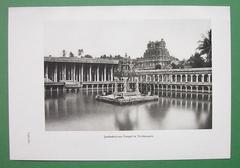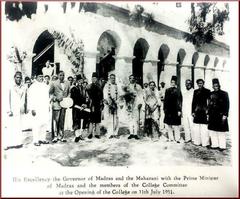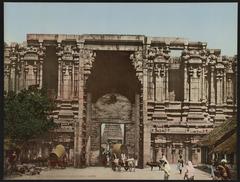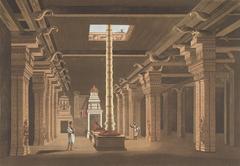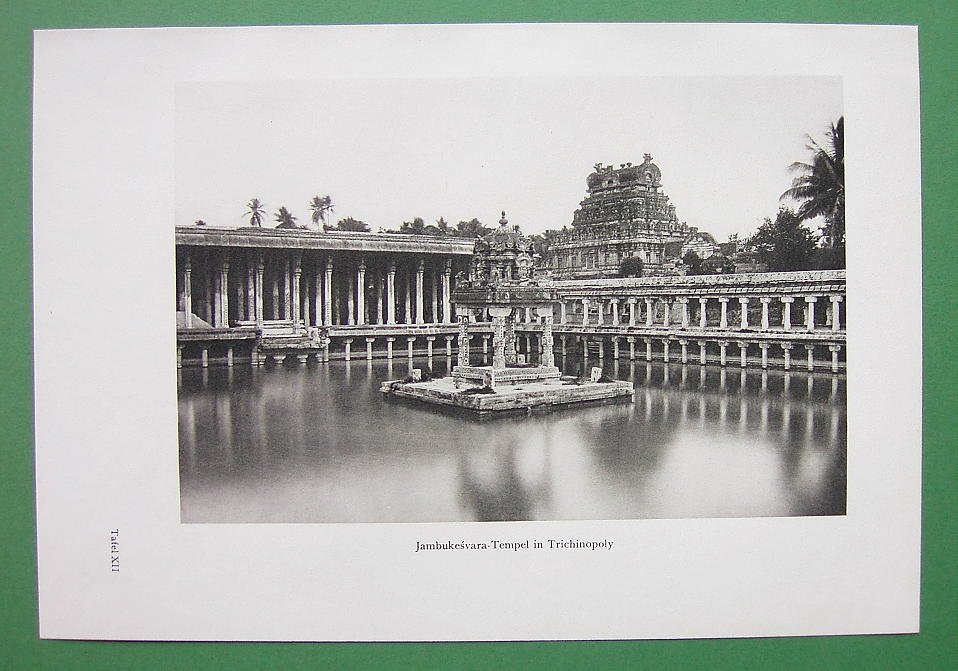
Jambukeswarar Temple Visiting Hours, Tickets, and Comprehensive Guide – Tiruchirappalli, Tamil Nadu
Date: 14/06/2025
Introduction
Jambukeswarar Temple, located in Thiruvanaikaval near Tiruchirappalli (Trichy), Tamil Nadu, is a celebrated marvel of Dravidian architecture and a spiritual beacon for Shaivite devotees. Renowned as one of the Pancha Bhoota Sthalams, it uniquely represents the element of water (Appu/Neer) through its sanctum, where a self-manifested (Swayambhu) Shiva lingam is continuously bathed by an underground stream. The temple’s heritage spans the early Chola period and reflects centuries of dynastic patronage, vibrant legends, and a living tradition of Tamil spirituality and culture. This guide offers detailed insights into the temple’s history, architecture, visitor information, festivals, travel tips, and practical details to ensure an enriching and memorable visit (Behind Every Temple; Pragyata).
1. Historical and Spiritual Significance
Origins and Dynastic Patronage
Jambukeswarar Temple’s roots trace back to circa 600 BCE, attributed to King Kochengannan of the early Chola dynasty. Excavated inscriptions detail further enhancements by Chola, Hoysala, and Nagarathar patrons, with the complex today spanning nearly 18 acres (Behind Every Temple). The temple is a revered Paadal Petra Sthalam, praised in the hymns of Tamil Shaivite saints and cherished in the collective memory of generations.
The Pancha Bhoota Sthalam and Water Element
Among the five sacred Shiva temples symbolizing the natural elements, Jambukeswarar represents water (Appu/Neer). The main lingam is perpetually bathed by water from an underground spring, even during droughts — a phenomenon that reinforces the temple’s sanctity and mystical allure (Hindu Blog).
Legends and Divine Narratives
The temple’s spiritual aura is deepened by timeless legends:
- Goddess Akhilandeswari’s Penance: Parvati, as Akhilandeswari, performed penance under a Jamun (Naaval) tree, shaping a lingam from the Cauvery’s waters and sanctifying the site.
- Sage Jambu’s Piety: Sage Jambu’s devotion led to the sprouting of a jamun tree from his head, giving the temple its name.
- The Spider and the Elephant: Devotion in diverse forms by a spider and an elephant resulted in their spiritual liberation, commemorated in the temple’s design (TN Temples Project).
2. Temple Layout and Architectural Highlights
Five Prakarams (Concentric Enclosures)
The temple is organized into five grand prakarams, symbolizing the journey from the earthly to the divine:
- First (Outer) Prakaram: Features lush gardens, festival spaces, and administrative offices.
- Second and Third Prakarams: Host pillared corridors, subsidiary shrines, and temple tanks; the third is known for its coconut grove and ritual tank.
- Fourth Prakaram: Houses the famed Ayiram Kaal Mandapam (Hall of 1,000 Pillars – actually 769), a masterpiece of stone carving (Trip101).
- Fifth (Innermost) Prakaram: Contains the sanctum (garbha griha) and the shrine of Goddess Akhilandeshwari.
Gopurams: Ornate Gateway Towers
The temple’s two prominent gopurams, richly adorned with stucco sculptures and vivid colors, stand as visual beacons. The tallest rises 73 feet, demarcating the sacred space (TravelTriangle).
Sanctum Sanctorum and Jala Lingam
The sanctum, accessible via a low doorway, evokes humility and reverence. The Swayambhu lingam is bathed by a perennial underground stream, with priests’ garments often soaked, especially during the monsoon (Wikipedia). The chamber is modestly adorned, illuminated by ghee lamps, and enveloped in a mystical ambience.
Shrine of Akhilandeshwari
Adjacent to the main sanctum, the Akhilandeshwari shrine features an ornate vimana and houses the Thadanga (earrings) consecrated by Adi Shankara. This is a focal point for women devotees seeking blessings for marital harmony (Culture and Heritage).
Temple Tanks and Sacred Water Features
Nine water bodies, especially the Sivaganga tank, play a key role in temple rituals and festivals, reinforcing the site’s elemental theme (eindiatourism.in).
Artistic and Sculptural Excellence
The temple is replete with Chola-era bas-reliefs, inscriptions, and carvings depicting the temple’s legends, deities, and mythological motifs (Culture and Heritage). The Ayiram Kaal Mandapam is especially renowned for its intricate pillars.
Ritual Spaces and Unique Features
- Noon Pooja: A unique midday ritual where the priest, embodying Goddess Parvati, worships Shiva (Culture and Heritage).
- Annabhishekam: Daily ablution of the lingam with cooked rice.
- Nadhaswaram School: The temple supports a traditional music school, reflecting its cultural vitality (templepurohit.com).
Materials and Construction
Built predominantly of granite, the temple showcases exemplary Chola engineering in its massive stones, pillared halls, and stuccoed gopurams (Trip101).
3. Visiting Hours, Tickets, and Practical Information
Timings
- General Opening Hours: 5:30 AM – 1:00 PM; 3:00 PM – 8:30/9:00 PM daily (Gotirupati; SriRam Travel).
- Darshan Duration: 15–20 minutes on weekdays; longer during weekends and festivals.
Entry Fees and Tickets
- General Entry: Free for all visitors.
- Special Darshan/Pooja Tickets: Available at the temple office, especially during festivals and special rituals (Poojn.in).
Dress Code and Etiquette
- Modest attire required (shoulders and knees covered); traditional Indian wear preferred.
- Shoes must be removed before entry; racks provided.
- Silence and respectful behavior are expected inside the complex (Gotirupati).
Accessibility
- Wheelchair access is available at main entrances and outer corridors, though the innermost sanctum requires navigating steps.
- Benches and shaded rest areas are available; assistance is recommended for elderly and differently-abled visitors (eindiatourism.in).
Facilities and Amenities
- Annadanam (Free Lunch): Daily from 12 PM–2 PM for about 100 devotees.
- Restrooms and Water: Located near entrances.
- Shops: Vendors offer flowers, coconuts, incense, and souvenirs.
4. Travel and Tourist Information
How to Reach
- By Air: Tiruchirappalli International Airport (13–15 km); taxis and autos available (PrayerPeak).
- By Train: Tiruchirappalli Junction (8–12 km); local transport options widely available (TFIGlobalNews).
- By Road: Regular buses and taxis from central Trichy and bus stands (Tripnetra).
Best Time to Visit
- Weather: October to March offers pleasant temperatures (19°C–22°C).
- Festivals: Maha Shivaratri, Panguni Brahmotsavam, and Aadi Fridays are vibrant but crowded (Culture and Heritage).
- Avoiding Crowds: Weekdays and early mornings.
Accommodation
- Choices range from budget lodges to mid-range hotels (e.g., Hotel Rock Fort View, Hotel Grand Stay); advance booking advised during festivals (PrayerPeak).
5. Festivals and Cultural Events
- Panguni Brahmotsavam (March–April): Grand chariot procession, dance, and music performances (Culture and Heritage).
- Maha Shivaratri: Night-long vigils and special abhishekams.
- Aadi Pooram: Celebrating Akhilandeshwari’s Shakti traditions.
Guided tours and cultural programs are often available during festival times.
6. Nearby Attractions in Tiruchirappalli
- Sri Ranganathaswamy Temple: One of the world’s largest temple complexes.
- Tiruchirapalli Rock Fort: Offers panoramic views and history.
- Samayapuram Mariamman Temple: Famous for goddess worship.
- St. John’s Church: Colonial-era heritage (TFIGlobalNews).
7. Essential Tips for Visitors
- Check festival calendar for events and special timings.
- Carry water, especially in summer; use sun protection.
- Arrive early for peaceful darshan.
- Use prepaid or trusted transportation.
- Learn basic Tamil greetings; English and Hindi are widely understood.
- Respect local customs and join in rituals respectfully.
8. Frequently Asked Questions (FAQ)
Q: What are the temple’s visiting hours?
A: 5:30 AM – 1:00 PM and 3:00 PM – 8:30/9:00 PM daily.
Q: Is there an entry fee?
A: No fee for general darshan; special pooja tickets incur a nominal charge.
Q: How can I book special poojas?
A: At the temple office upon arrival.
Q: Is the temple accessible for differently-abled visitors?
A: Wheelchair access is available in the outer precincts; assistance is recommended.
Q: Are guided tours available?
A: Yes, via local agencies and Tamil Nadu Tourism.
Q: Is photography allowed?
A: Permitted in outer areas, but restricted inside the sanctum; always ask for permission.
9. Visuals and Media Suggestions
- Include high-resolution photos of gopurams, Ayiram Kaal Mandapam, the sanctum, and festival scenes.
- Use alt text like “Jambukeswarar Temple gopuram at sunrise” or “Devotees at Panguni Brahmotsavam.”
- Embedding Google Maps location and virtual tour links enhances planning.
10. Summary and Final Tips
Jambukeswarar Temple is a living monument of faith, artistry, and Tamil culture. Its unique water element, grand architecture, and vibrant rituals offer a profound spiritual and cultural experience. Plan ahead, respect traditions, and immerse yourself in the temple’s serene and mystical atmosphere.
Sources and Further Reading
- Behind Every Temple
- Pragyata
- Culture and Heritage
- PrayerPeak
- Tripnetra
- Trip101
- TravelTriangle
- TFIGlobalNews
- Gotirupati
- SriRam Travel
- Wikipedia
- eindiatourism.in
- templepurohit.com
Ready to discover more? Download the Audiala app for interactive guides, festival updates, and curated experiences at Jambukeswarar Temple. Share your journey and connect with the community for travel inspiration!
